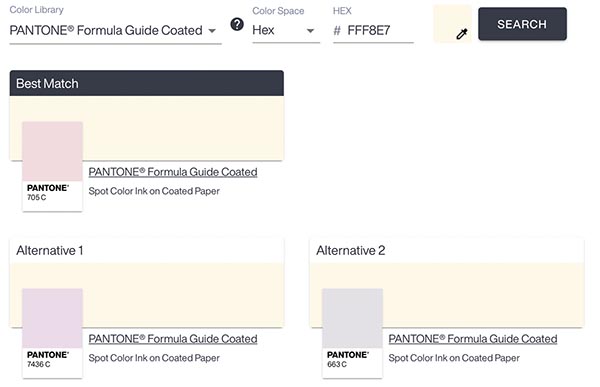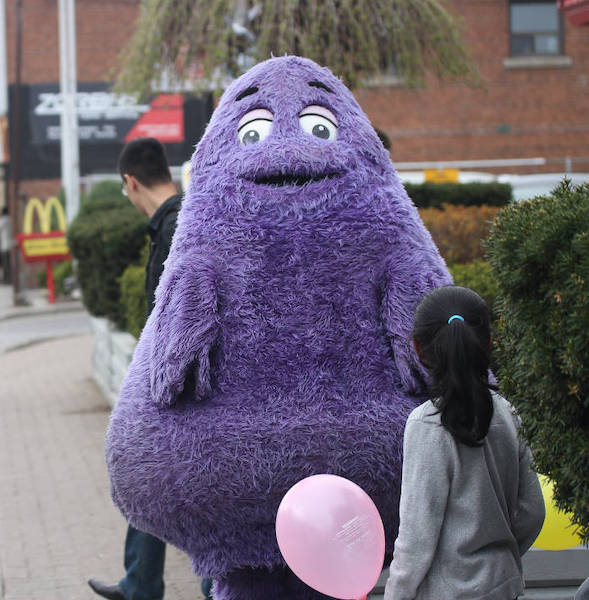Your (Attempted) Friday Bass Cover of Tears for Fears’ “Mad World”
The photo that sums up 2021. pic.twitter.com/k8EN4mL6or
— Derf Backderf (@DerfBackderf) August 30, 2021
Five Leaves Left
Summer is drawing to an end and autumn is just around the corner. If leaf-peeping is your thing, we offer you this Fall Foliage Prediction Map courtesy SmokyMountains.com. Adjust the slider to see where and when the foliage will be at its most colorful.

High Water Mark
Journalism: Come Hell And High Water, Then And Now
— Dan Barry (@DanBarryNYT) September 1, 2021
- a Katrina “souvenir,” 2005 pic.twitter.com/OF95WrtzsK
Anthracite for Sore Eyes
There is not a lot of good to say about coal from an environmental perspective, but one company is at least trying to mitigate some of the damage by turning coal ash into fibers, reducing the need to use more valuable raw materials.
As it is with many revolutionary technologies past and present, it is the innate desire to solve an existing or emerging national crisis that gives birth to these ground-breaking innovations. Such is the case with GCS’ coal ash-to-mineral fiber conversion technology and our affiliate company’s (Eco Green Solutions) coal powered plant emissions capture technology. The global challenge to uncover a more comprehensive, safer and cost-effective solution for the management of coal ash has now been fulfilled through GCS. Be it fly ash, bottom ash, boiler slag, wet or dry coal ash, GCS’ operations can convert millions of tons of toxic coal ash from any kind of coal each year into 6 base mineral fibers that can be used to manufacture end-products such as paper, brake pads, textiles, building insulation, rubber and plastics, and carbon fiber precursors. All the while, providing as many as 500 direct jobs at each factory and cleaning up the harmful effects of coal ash across the country.
Seeing Red
Sorry but this is the best thing ever https://t.co/qase6Uy0SI
— John Fugelsang (@JohnFugelsang) August 31, 2021
UR-Hell
Do you like websites? And bad design? And crippling headaches? If so, good news! You’ll want to bookmark Websites From Hell and check back often, as it is a compilation (1,174 at present) of the worst in website design. While some date back to a time when bad web design was the norm, there are new examples being added often. You can search by domain, by color, or by “most hellish.” You can also “Become an Inquisitor” and submit your own example.

So True!
We need a punctuation mark that communicates the positivity of the exclamation point without the insanity
— Mike Royce (@MikeRoyce) August 6, 2021
Across the [Beige] Universe
This week, Live Science’s Life’s Little Mysteries series asked, “What is the average color of the universe?” First off, don’t even think “black.”
"Black is not a color," Ivan Baldry, a professor at the Liverpool John Moores University Astrophysics Research Institute in the U.K., told Live Science. "Black is just the absence of detectable light." Instead, color is the result of visible light, which is created throughout the universe by stars and galaxies, he said.
So, in 2002, Baldry and Karl Glazebrook measured the light coming from tens of thousands of galaxies and from it created a spectrum for the universe. From that, they were able to calculate the average color of the universe. Their study was published in The Astrophysical Journal.
What is the average color of the universe? Gotta say, you’re not gonna like it. It’s…beige. Yes, beige. Literally all the color in the universe averages out to beige. (Kind of makes sense when you think about it, disappointing though it may be.) However, they did decide to call it “cosmic latte” instead to maybe jazz it up a bit.
It is represented by the hexadecimal #FFF8E7, and even more disappointingly, there is no closely correspondingPantone color:

Dog Days
My new favourite WFH problem. I don’t know why, it just gets funnier pic.twitter.com/NiIX5osHh7
— rose (@rosevalentee) August 30, 2021
Pooling Their Resources
Was it a good week for graphene news? It’s always a good week for graphene news! Summer may be winding down, but when next year comes around, and temperatures soar even higher (cause that’s the way we roll these days, apparently), it may be time to finally put in that swimming pool, and what could be better than a graphene-enhanced swimming pool?
Aquatic Leisure Technologies (ALT) recently announced the world’s first commercial range of graphene-enhanced GFRP swimming pools. This follows June 2020's announcement of First Graphene (FGR) entering an agreement with Aquatic Leisure Technologies to supply PureGRAPH products for development of pool innovations.
Graphene Nano-Tech pools, which ALT claims are lighter, stronger and more durable than traditional GFRP pools, are manufactured using a process that combines graphene-infused resin with traditional GFRP fabrication.
… FG expects graphene GFRP technologies to be deployed across the leisure pools industry and in marine, water engineering and sports equipment markets. Emerging prototypes include a graphene GFRP surfboard and the first graphene-enhanced boat, which was built by Ascent Shipwrights in Perth, Australia, and is currently undergoing sea trials.
It’s a safe bet Cary Sherburne would love to beta test it.
Flavor of the Month
Ok, sure - we all know some letters fell off. But for the life of me I can’t figure out what the hell donut it was supposed to be. pic.twitter.com/HGEKA1inTR
— jason alexander (@IJasonAlexander) August 26, 2021
Dialing for Doom
Depending on who’s calling, just about any phone could be considered a “doom phone,” but software engineer Neil Bostian explains in rather meticulous detail how he hacked a business phone to run the first-person shooter game Doomand thus create the DoomPhone.

The grueling experience also resulted in some life lessons learned.
You are the sum of your experiences, not in years, but instead in some imaginary "experience points". Live your life such that you maximize XP points in the various skills and achievements that matter most to you. For me, one of those skills happens to be making DOOM run in places it wasn't intended.
Won’t Get Fooled Again
i got fooled. i got fucking clowned on and embarrassed pic.twitter.com/xDEe2tYyyn
— rob (@OkButStill) August 31, 2021
Woodcro
You have to love a story that begins, “There's no practical application I can see…” But, via Core77, a Japanese craftsman named Kurahito turned wood into Velcro.
Again, no real practical use for this, but kind of cool nonetheless.
Tears of My Tracks
— You can pick my brain when that invoice is paid. (@DrBWillingham) August 7, 2021
Important Developments
Gizmodo asks, “What is the most important scientific development of the last 50 years?” (Before you say “the steam engine” or “space flight” or even “sliced bread,” remember that 50 years ago was 1971.) They asked a number of scientific experts, and candidates included gene sequencing and mapping genomes; Polymerase Chain Reaction (PCR— “It enables sequencing and genetic fingerprinting, and we have it to thank for COVID tests and vaccine development”); and “discovery and proof of global warming.”
Advice for The Great Resignation
Can you help me get rid of the corpse of the guy you’re replacing? https://t.co/bpZvu57Z0f
— The Onion (@TheOnion) September 1, 2021
Poor Sports
They say that when all that you have is a hammer, everything looks like a nail. Likewise, when all you have is a bowling ball, every sport looks like bowling. Via Laughing Squid, filmmaker Sam Buchanan envisions various sports—golf, tennis, pool, field hockey, etc.—as if they were played with bowling balls.
The Song Doesn’t Remain the Same
Not many advantages in getting old, shuffling towards the grave in your slippers needing a wee and your eyebrows mowing, but one good thing is that all the stuff - songs, films etc - that as a younger person you'd pretend to like 'ironically', you can now just admit to liking.
— Simon Blackwell (@simonblackwell) August 27, 2021
Veni Vidi Vending
We are all familiar with the vending machine, whether it dispenses beverages or various kinds of snacks that always seem to get snagged while dispensing and require the tackling power of a linebacker to dislodge. We were bemused sometime in the 1990s (or maybe 2000s) when vending machines selling electronics started appearing. But in Portland, Ore., Taylor Valdés has cornered the market on vending machines that dispense homemade arts and crafts. Says The Oregonian:
One third of the treasures inside are handcrafted by Valdés in her home garage studio. She paints vibrant hues of red, blue and green to form an eyeball on an eyepatch. Another day she packages mini plastic animal figurines into brown baggies with “Find your inner animal” printed on the front. The small toy comes with a written note by Valdés, informing the customer of the energy related to the animal.
Another third of the items come from Valdés’ hunts at the Goodwill Outlet store. Typically the store is so crowded that no shopping carts are left by the time she walks through the automatic sliding doors. So she grabs a rolling desk chair and fills it with finds from the bright blue bins. Specifically, Valdés looks for used books and CDs that are just the right size to fit into her machines.
…Valdés pairs up with hundreds of local artists to make up the remaining third of her vending machine products.
Calling her machines The Venderia, Valdés has now installed 18 of her machines around the Portland area, where they have become a bit of a hit. During the pandemic, she “pivoted” and started an online course for people interested in starting a non-traditional vending machine business.
New non-traditional vending machine owners have popped up in St. Petersburg, Austin, Long Beach, Boise, Salt Lake City and more after taking the course.
“We’ve built a community of creative vending machine operators.” Valdés said. “I think that this model can be adapted to any setting.”
The Museum of Printing, for example, could set up a vending machine to dispense bits of wood type or other tschotskes kicking around.
Just Cheer Up
Can’t wait for someone to tell her to just start exercising https://t.co/caX4F0JHBX
— Jess Dweck (@TheDweck) August 31, 2021
Loves Me Like a Different Rock
A couple of weeks ago, we mentioned an NFT which was a clip art drawing of a rock that sold for $272,679, for reasons passing understanding, and we happened to mention the thankfully short-lived Pet Rock fad in the 1970s. This week, Boing Boing flashes back to the original Pet Rock and points out that they are actually still available. There was also a commercial (channeling Dickie Goodman) which thankfully those of us who lived through the 70s had forgotten:
Still, the Pet Rock makes more sense than NFTs.
This Bud’s Just for You, Really
They really only needed to come in twin. https://t.co/LCtxKCfj6p
— J. Elvis Weinstein (@JElvisWeinstein) September 1, 2021
Best Buds
Some of you may recall, back in the day, that McDonald’s advertising and other branding featured a whole host of characters, in addition to of course, the titular Roland. There was the Hamburglar, Mayor McCheese, and a few other characters introduced over the years. And then there was Grimace, a big, purple sort of monsterish thing.

What exactly was he/she/it supposed to be? After decades of speculation, and artful dodges by the company itself, in an interview with HuffPost (via Boing Boing), the manager of a McDonald’s franchise in Canada, and a 10-year veteran of the company, reveals all…and it’s kind of disturbing.
“He is an enormous taste bud, but a taste bud nonetheless,” Bates told the network in an “unofficial” explanation, adding that the character was meant to show that the food tastes good.
Once you know it, you can’t unknow it. Although, for some, the revelation poses more questions than it answers:
If Grimace is a taste bud meant to show how good the food is why on earth would you name the damn thing after an expression of disgust https://t.co/L51ve89QCV
— ?Shannihilator the Pastry Wizard???????? (@8bitonionring) September 2, 2021
That’s a perfectly fair question—perhaps his name reflects one’s reaction upon learning what he is.
Vicious Circle
All this has happened before, and all this will happen again. https://t.co/IuDlsXZWGU
— Dr. Tara C. Smith (@aetiology) August 30, 2021
This Week in Printing, Publishing, and Media History
August 30
1797: Mary Shelley, English novelist (Frankenstein) and playwright, born.
1909: Burgess Shale fossils are discovered by Charles Doolittle Walcott, which would serve as the subject for one of the best science books ever written: Stephen Jay Gould’s Wonderful Life.
1956: Comedian, actor, producer, and screenwriter Frank Conniff (“TV’s Frank” from Mystery Science Theater 3000), born.
August 31
1688: English preacher, theologian, and author (Pilgrim’s Progress) John Bunyan dies (b. 1628).
1867: French poet and critic Charles Baudelaire dies (b. 1821).
1895: German Count Ferdinand von Zeppelin patents his navigable balloon. It went over like a...well, actually it went over rather well (for a bit).
1897: Thomas Edison patents the Kinetoscope, the first movie projector.
1944: English illustrator Roger Dean born.
September 1
1795: American publisher, founder of the New York Herald James Gordon Bennett, Sr. born.
1878: Emma Nutt becomes the world’s first female telephone operator when she is recruited by Alexander Graham Bell to the Boston Telephone Dispatch Company. (Appropriately, Lily Tomlin was born on this same day in 1939. The over-50-year-olds out there will get the connection.)
1991: German graphic designer and typographer Otl Aicher dies (b. 1922).
September 2
1752: Great Britain, along with its overseas possessions, adopts the Gregorian calendar.
1963: The CBS Evening News becomes U.S. network television's first half-hour weeknight news broadcast, when the show is lengthened from 15 to 30 minutes.
1973: English novelist, short story writer, poet, and philologist J. R. R. Tolkien dies (b. 1892).
2013: American author and publisher Frederik Pohl dies (b. 1919).
September 3
1802: William Wordsworth composes the sonnet “Composed upon Westminster Bridge, September 3, 1802.”
1883: Russian author and playwright Ivan Turgenev dies (b. 1818).
1962: American poet and playwright e. e. cummings dies (b. 1894).
1967: Dagen H in Sweden: Traffic changes from driving on the left to driving on the right overnight.
September 4
1888: George Eastman registers the trademark “Kodak” and receives a patent for his camera that uses roll film.
1908: American novelist, short story writer, essayist, and poet Richard Wright born.
1951: The first live transcontinental television broadcast takes place in San Francisco, from the Japanese Peace Treaty Conference.
1972: The Price Is Right premieres on CBS. As of 2021, it is the longest running game show on American television.
1998: Google is founded by Larry Page and Sergey Brin, two students at Stanford University.
September 5
1977: NASA launches the Voyager 1 spacecraft. Voyager 1 (like the other voyager probes) contained what was called the “Golden Record,” a gold-plated audio-visual disc that contains photos of the Earth and its lifeforms, scientific information, spoken greetings from people such as the Secretary-General of the United Nations and the President of the United States, a medley of "Sounds of Earth" (the sounds of whales, a baby crying, and waves breaking on a shore, in case aliens are into New Age music), and a collection of musical works by Mozart, Blind Willie Johnson, Chuck Berry, and Valya Balkanska. In 2013, Voyager 1 became the first manmade object to leave the Solar System.
1929: American comedian and actor Bob Newhart born, who did more for the telephone than Alexander Graham Bell.
1945 (not the Year of the Cat): Scottish singer-songwriter and guitarist Al Stewart born.
1946: Tanzanian-English singer-songwriter and producer Freddie Mercury born.















Discussion
Only verified members can comment.